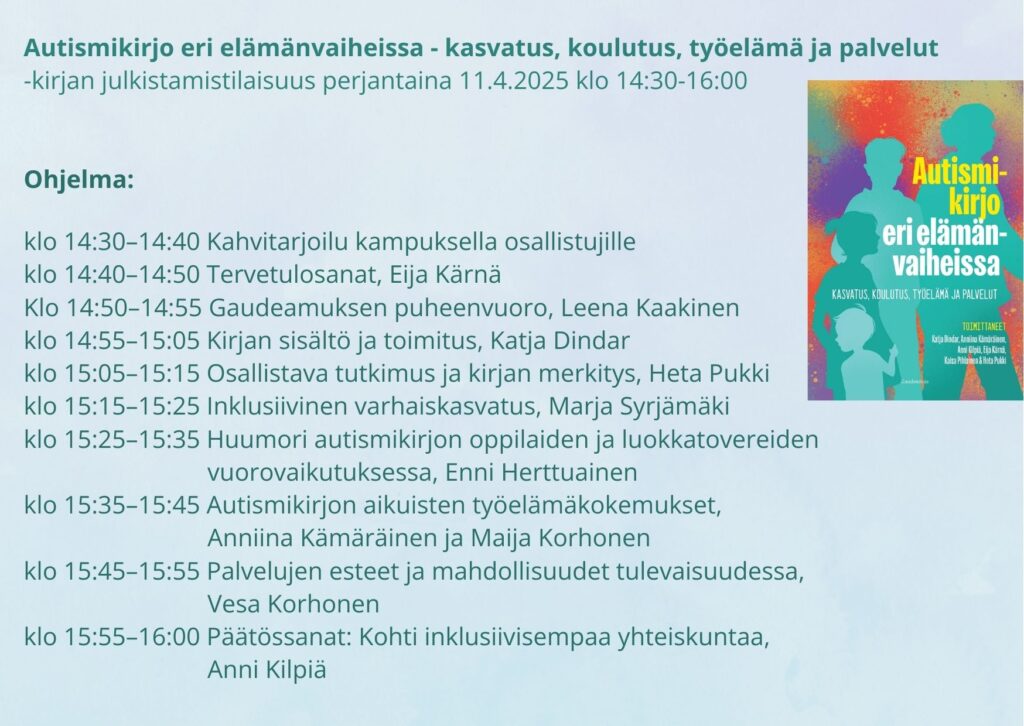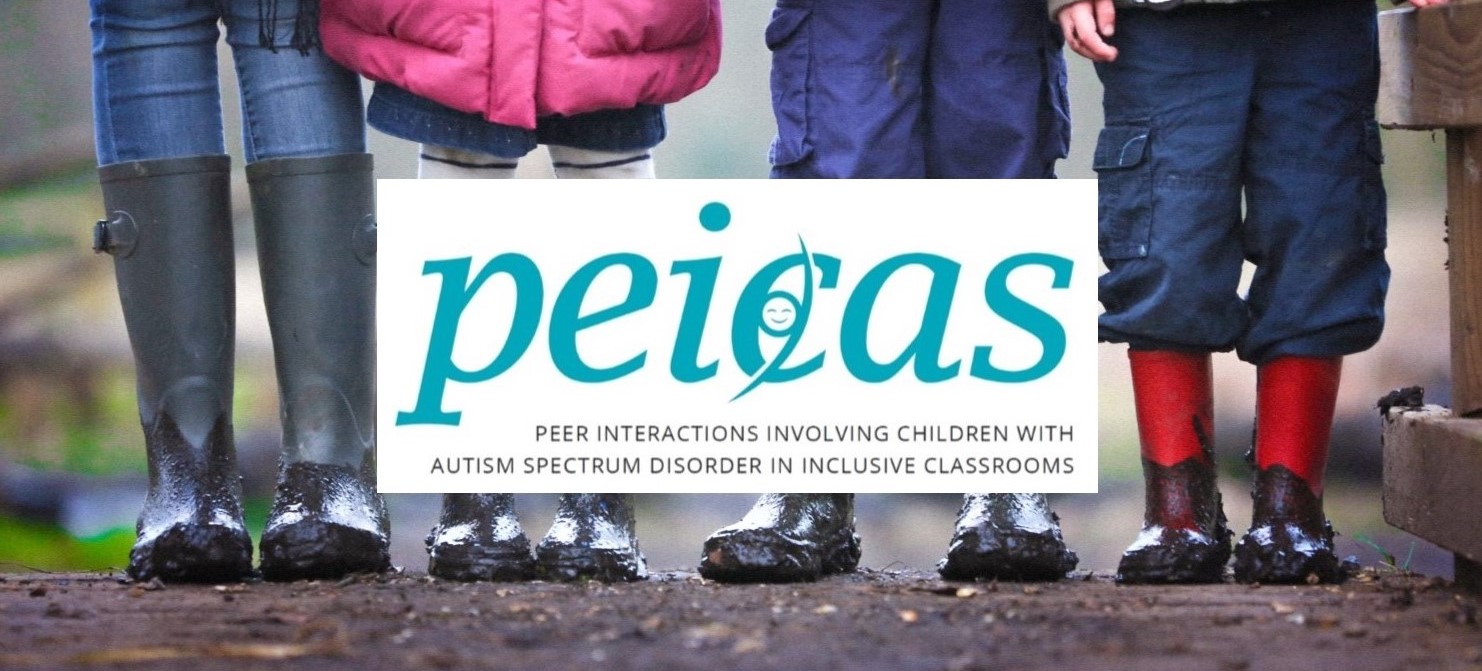Itä-Suomen yliopiston koordinoima ja Suomen Akatemian rahoittama kansainvälinen ja monitieteinen PEICAS-tutkimushanke alkoi syyskuussa 2019 ja päättyi joulukuussa 2024. Hankkeessa lisättiin ymmärrystä ja keinoja tukea autismikirjon lasten sosiaalista osallisuutta inklusiivisissa luokissa. Useat hankkeen julkaisut ovat vielä arviointiprosessissa, joten päivitämme verkkosivuja edelleen uusien julkaisujen osalta.
Ajankohtaisia kuulumisia 1/2025
Toimittamamme kirjan Autismikirjo eri elämänvaiheissa — Kasvatus, koulutus, työelämä ja palvelut julkistamistilaisuus pidettiin perjantaina 11.4. Lämmin kiitos kaikille osallistuneille paikan päällä ja etänä!

Hankkeen uudet julkaisut
Dindar. K., Kämäräinen, A., Kilpiä, A., Kärnä, E., Pihlainen, K. & Pukki, H. (2025.). Autismikirjo eri elämänvaiheissa – Kasvatus, koulutus, työelämä ja palvelut.
Dindar, K., Kotila, A., Mäkinen, L., Pirinen, V. & Loukusa, S. (2025). Autismikirjon lasten kommunikaatio- ja vuorovaikutustilanteiden tukeminen. Teoksessa K. Dindar, A. Kämäräinen, A. Kilpiä, E. Kärnä, K. Pihlainen & H. Pukki (toim.), Autismikirjo eri elämänvaiheissa: Kasvatus, koulutus, työelämä ja palvelut. Gaudeamus.
Herttuainen, E., Kämäräinen, A., Dindar, K. & Kärnä, E. (2025). Huumori autismikirjon oppilaiden ja luokkatovereiden vuorovaikutuksessa. Teoksessa K. Dindar, A. Kämäräinen, A. Kilpiä, E. Kärnä, K. Pihlainen & H. Pukki (toim.), Autismikirjo eri elämänvaiheissa: Kasvatus, koulutus, työelämä ja palvelut. Gaudeamus.
Pihlainen, K., Anniina Kämäräinen, A., Suero Montero, C., Kärnä, E. (2025). Autismikirjon oppilaiden näkemyksiä onnistuneesta ryhmätyöskentelystä. Teoksessa K. Dindar, A. Kämäräinen, A. Kilpiä, E. Kärnä, K. Pihlainen & H. Pukki (toim.), Autismikirjo eri elämänvaiheissa: Kasvatus, koulutus, työelämä ja palvelut. Gaudeamus.
Kämäräinen, A., Kilpiä, A., Kyllönen, A., Saarelainen, H. & Pihlainen, K. (2025). Autismikirjon aikuisten moninaiset työelämäpolut. Teoksessa K. Dindar, A. Kämäräinen, A. Kilpiä, E. Kärnä, K. Pihlainen & H. Pukki (toim.), Autismikirjo eri elämänvaiheissa: Kasvatus, koulutus, työelämä ja palvelut. Gaudeamus.
Kähkönen, E., Kämäräinen, A. & Kärnä, E. (2024). ”Se ny vaan oli semmone olosuhteiden tragedia” – koulu instituutiona autismikirjon aikuisten kertomuksissa. Kasvatus 55(5), 507-523.
Kämäräinen, A., Kärnä, E., Olli, P., Romppanen, L., Kilpiä, A., Dindar, K., Pihlainen, K. & Suero Montero, C. (2024) Direktiivit autismikirjon oppilaan ja luokkatovereiden yhteistä tarinankerrontaa ohjaamassa. Puhe ja kieli, 44(2), 67-86.
Hankkeen uusia opinnäytteitä
Jaakonsaari, E. & Sormunen, M. (2025). Oppilaiden tehtäväsuuntautuneen ja ei-tehtäväsuuntautuneen puheen siirtymät ryhmätyöskentelytilanteessa http://urn.fi/urn:nbn:fi:uef-20250606
Karsikas, A. & Savinainen, A. (2025). Autismikirjon oppilaiden ja vertaisten kysymykset ja
responssit ryhmätyöskentelytilanteissa. http://urn.fi/urn:nbn:fi:uef-20250698
Luoma, M. (2025). Autismikirjon oppilaiden ja luokkatovereiden ryhmätyöskentelyn rakentuminen kysymysten ja vastausten avulla. http://urn.fi/urn:nbn:fi:uef-20250634
Ahvo, I. (2024). Autismikirjon aikuisten kertomukset siirtymistä peruskoulusta ammattikouluun ja ammattikoulusta työelämään. https://erepo.uef.fi/handle/123456789/31900
Dafoe, E. & Määttä, J. (2024) Vuorovaikutuksessa puheella niukasti osallistuvien oppilaiden aloitteet ja responssit ryhmätyöskentelyssä. http://urn.fi/urn:nbn:fi:uef-20240857
Viimeaikaisia hankkeen esityksiä
21.-22.11.2024 Kasvatustieteen päivät, Enni Herttuainen piti esityksen aiheesta Autismikirjon oppilaiden ja luokkatovereiden jaettu huumori tarinankerrontatilanteissa ja Anniina Kämäräinen aiheesta Luokkatoverit tukemassa neurokirjon oppilaan osallisuutta ryhmätyöskentelytilanteessa
8.-9.11.2024 Autismikirjon syyspäivät, Eija Kärnä osallistui paneelikeskusteluun
14.-16.8.2024 Psykologia kongressi, Anni Kilpiä piti esityksen aiheesta alakouluikäisten autismikirjon oppilaiden ja luokkatoverien vuorovaikutus ryhmätyötilanteissa
13.6.2024 Translational research on neurodevelopmental disorder -workshop, Eija piti esityksen hankkeen tuloksista
19.4.2024 Autismitutkimus Suomessa -webinaari, Anni Kilpiä piti puheenvuoron Autismikirjon aikuisten moninaisista työelämäpoluista ja hankkeen tutkijatohtorit Katja Dindar ja Anniina Kämäräinen toimivat webinaarin suunnittelutyöryhmässä

